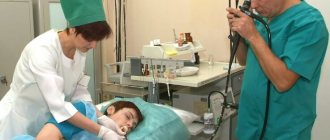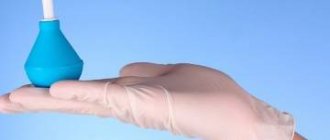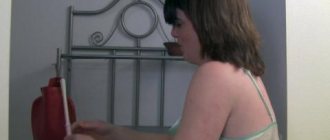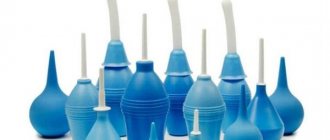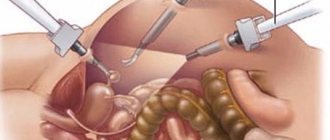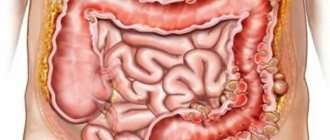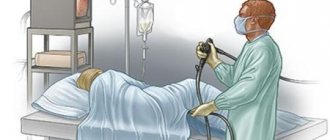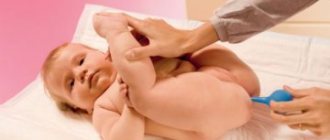Medicinal drip enema
Purpose: administration of the drug into the rectum
Indications:
- local effect on the mucous membrane of the lower colon ( sea buckthorn oil, chamomile infusion
, etc.), - resorptive effect on the body (digitalis preparations, chloral hydrate
, etc.). - impossibility or undesirability of oral or parenteral administration of drugs
Contraindications:
- acute inflammatory and ulcerative processes in the lower parts of the colon;
- fissures in the anal area.
Equipment:
- sterile system for drip enema: gas outlet tube, disposable system for drip administration of liquid, bottle with medicinal solution;
- Vaseline oil; gloves;
- cotton cover for a bottle or heating pad (2 pcs), water thermometer;
- oilcloth, diaper.
Required conditions:
- 30-40 minutes before the drip enema, you need to give a cleansing enema;
- During the manipulation, maintain the temperature of the injected solution within 40-42 0 C (taking into account heat transfer).
| STEPS | JUSTIFICATION |
| Preparation for the procedure | |
| 1. Explain to him the purpose, the course of the upcoming procedure, and obtain his consent. | Respect for patient rights. |
| 2. Fill the system with a medicinal solution, secure the bottle on a stand 1 meter above the level of the patient’s intestines. | Condition for the manipulation. |
| 3. Place a screen near the patient’s bed. | Provide isolation and comfortable conditions. |
| 4. Place an oilcloth or diaper under the patient. | |
| 5. Place the patient on his left side, legs bent at the knees and brought to the stomach. If it is impossible to place the patient on his left side, the enema is given in the “supine” position. | Condition for the manipulation. Acceptable position for this procedure. |
| 6. Wash and dry your hands and put on gloves. | Ensuring infection safety. |
| Executing the procedure | |
| 1. Lubricate the gas outlet pipe of the system with petroleum jelly. | To facilitate its insertion into the rectum. |
| 2. Bend the tube over your hand, pinch its free end with the 4th and 5th fingers of your right hand, and take the rounded end like a pen. | The leakage of intestinal contents during insertion of the tube is prevented. |
| 3. Spread the patient’s buttocks with 1-2 fingers of the left hand and insert a gas outlet tube connected to the system into the intestine to a depth of 20-30 cm. | Condition for the manipulation. |
| 4. Adjust the frequency of drops of the administered drug using a clamp. | Liquid in the intestines is absorbed better if it comes in drops. |
| 5. Wrap the bottle with the medicinal solution in a cotton cover or heating pads filled with water at 60-70 0 C. Note: as the solution cools, the heating pads must be changed. | Maintaining the temperature of the injected solution. |
| 6. Cover the patient with a blanket. | Providing comfortable conditions. |
| End of the procedure | |
| 1. Close the screw clamp and slowly remove the gas outlet tube from the anus. | Prevention of the urge to defecate. |
| 2. Clean the patient's anus using toilet paper or wash it. | Ensuring a comfortable state after the procedure. |
| 3. Place the gas outlet tube in a container with a disinfectant solution. | Ensuring infection safety. |
| 4. Remove gloves and place in a container with a disinfectant solution. | Ensuring infection safety. |
| 5. Wash and dry your hands. | Ensuring infection safety. |
Notes:
During the procedure, which lasts several hours, the nurse must ensure that: due to kinking of the tubes, the flow of solution into the intestines does not stop, a certain infusion rate is maintained, and the required temperature of the injected solution is maintained.
Medicinal microenemas
1. The drug can be administered into the intestines using a microenema (the volume of injected liquid is 50-100 ml).
2. The algorithm for administering a medicinal microenema is similar to the algorithm for administering a laxative enema.
3. Currently, ready-made medicinal microenemas are used, which are convenient for use even at home. Read the instructions before use!
4. It must be remembered that the temperature of the drug during administration should be 40-42 0 C.
Any therapeutic enemas for both adults and children are given only after prior consultation with a doctor. The effectiveness of treatment depends on the correctness of the cleansing or any other enema procedure.
Therapeutic enemas are mainly used for two purposes: to cleanse the intestines and to introduce medicinal substances into the colon.
Preparation for the procedure
To perform an enema at home, you need to buy an Esmarch mug with a glass or plastic tip or a rubber bulb, Vaseline, oilcloth, and a bedpan if necessary (for seriously ill patients) at the pharmacy.
An Esmarch mug is a rubber, plastic or silicone mug with a capacity of 1-3 liters with a flexible rubber or plastisol outlet tube up to 2 m long.
Rubber bulbs can either be entirely rubber or have a plastic tip. The volumes of rubber bulbs may vary. Pears, which have a small volume, are used to cleanse the intestines in children and for administering medicinal enemas to adults. Large pears are intended to cleanse the intestines in adults.
Cleansing enema
It is done for the purpose of cleansing and rinsing the colon, eliminating constipation or fecal blockage, treating any poisoning or intoxication, before certain surgical operations, childbirth. In this case, the injected solution is initially intended for eruption and its absorption into the intestine is undesirable.
Features of performing an enema
An enema has a beneficial effect on the body and individual organs. When administered, including medication, absorption of the drug by the intestinal walls begins. If we talk about medicinal, it means more of a local effect. Of course, the body also benefits, only indirectly. The purpose of treatment is to influence the area of the body or organ that requires treatment.
A rubber bulb is used for staging. A less common option: a Janet syringe with a special catheter.
Indications for the procedure
Enema treatment is used for a wide range of diseases. It is advisable to consult a doctor before use. Moreover, when not just water or a decoction of herbs is administered, but a medicine. Below is a list of conditions for which colonic cleansing is used:
- Lack of results from taking laxatives.
- Incessant constipation.
- Infections in the rectal area.
- During illnesses when the use of sedatives and sleeping pills is required.
- Inability to administer the substance by alternative means.
- Inflamed rectum, sigmoid, small intestine.
- Inflammatory process of the prostate gland.
- Disturbed menstrual cycle.
- Cystitis.
In addition to the above, enemas are used before operations, intestinal examinations and childbirth.
A medicinal enema is administered for general purposes in the following cases:
- Undesirability of taking the medication and inability to take it orally.
- Liver dysfunction when nutrients and beneficial substances are not absorbed.
- The need to administer sleeping pills.
The composition of the solutions is varied. This includes medicinal herbs: chamomile, marshmallow, oak bark, valerian. Additionally, antibacterial drugs in the form of solutions, painkillers and others are used.
As mentioned above, a microenema differs from a regular cleansing one. The procedure is characterized by a small volume of administered drugs - from 50 to 200 ml. It produces a cleansing and local effect.
Contraindications
This type of enema is indicated for:
- lack of effect after taking laxatives;
- constant constipation;
- infectious diseases of the rectum;
- various diseases requiring the administration of sedatives and hypnotics;
- impossibility of administering drugs intravenously and parenterally.
In addition, local use of a medicinal enema is indicated for inflammation of the sigmoid, small, rectum (the basis of the medicinal mixture is collargol and chamomile alcohol extract), as well as the prostate gland (the active ingredient is antipyrine).
For general use, a medicinal enema is recommended when
- administration of medications is undesirable or cannot be administered orally;
- the patient has liver problems (the administered medications are not absorbed into the liver and do not have a negative effect on it);
- it is necessary to administer a sleeping pill, for example, containing chloral hydrate.
Medicinal enema is contraindicated in patients with:
- acute pain in the abdominal area of unknown nature;
- inflammation of the rectum, sections of the large and small intestines;
- anal injuries;
- bleeding of the gastrointestinal tract;
- intestinal oncology;
- the presence of protruding hemorrhoids;
- allergic rashes in the anal area;
- prolapse of the rectum, less often - of the large intestine;
- tumor conditions.
A number of pathological conditions when the use of medicinal enema is prohibited:
- oncological diseases;
- rectal prolapse;
- presence of hemorrhoids;
- internal bleeding;
- trauma to the anus and rectum;
- inflammatory processes in the intestines;
- abdominal pain of unknown etiology.
Medicinal enemas are useful: they contain drugs that are freely absorbed into the circulatory system, bypassing the liver. Procedures with solutions of medicines, decoctions of plants, salts, and oils have a therapeutic effect.
Circulatory system
The use of medicinal enemas is based on the ability of intestinal microvilli to absorb beneficial substances from drugs. Through the hemorrhoidal veins, the drug enters the inferior vena cava and then spreads throughout the body. When taking a medicine orally instead of an enema, the liver and stomach are subject to additional stress, and the medicine is affected by gastric juice and enzymes - the composition and properties of the drug change.
Before placing a medicinal enema, a cleansing procedure of the rectum is carried out, after which the drugs are better absorbed by the mucous membrane.
The patient is explained in advance the purpose, the course of the manipulation and prepared for the procedure:
- they fence off the person with a screen (if the ward is multi-bed);
- prepare items necessary for the procedure;
- place the patient in the correct position: on the left side with legs bent at the knees;
- An oilcloth is pulled under the lower part of the body.
The medical worker cleans and dries his hands, puts on an apron and gloves.
The medicine is heated in a water bath: the cold solution will cause the urge to defecate. After the procedure, the patient lies on the couch for an hour.
1. The patient is warned about the upcoming procedure. Since you need to lie down after it, it is better to give the enema at night in the ward. 2. 30 - 40 minutes before administering a medicinal microenema, a cleansing enema is given. 3. The medicine in the indicated dose is poured into a clean jar and heated in a water bath to a temperature of 37... 38°C. 4.
Take the medicine (50 - 200 ml), heated in a water bath, into a Janet syringe or rubber balloon. 5. Place an oilcloth under the patient, then a diaper and ask him to lie on his left side, pulling his legs, bent at the knees, towards his stomach. 6. A rectal tube (or catheter) is inserted into the rectum with a 20 cm rotational movement and connected to a Janet syringe (or balloon). 7.
Slowly push the medicine into the rectum. 8. Having finished the insertion, clamp the tube with your fingers, remove the syringe, draw a little air into it, connect the syringe to the tube again and, releasing the air from it, push it! remaining medication from the tube into the intestines. 9. Remove the syringe, clamp the tube, and carefully remove the tube from the rectum with rotational movements. 10. The patient is advised to take a comfortable position and not stand up.
Medicinal enema, technique of execution.
Notes To avoid irritation of the rectal wall and the urge to defecate, the concentration of the drug should be hypertonic. The medicine should be administered in small volumes. The medicine must be heated. After use, the rectal tube is soaked in a 3% chloramine solution for 1 hour. If a catheter is used instead of a rectal tube, it should be labeled and used only for insertion into the rectum. The manipulation should be performed with rubber gloves.
Algorithm for performing therapeutic enemas for the intestines
If the enema is administered correctly, there is no pain. You may experience an unpleasant feeling at the end of the procedure.
You need to know and follow the rules and sequence of actions - the algorithm. Correct administration of the solution ensures the absorption of medicinal substances by the body and immediate action.
Classification of therapeutic enemas
The following types of medicinal enemas are distinguished:
- Emollient, used for stool retention.
- Painkiller.
- Astringent.
- Annoying.
- Against parasites.
Stages of the procedure:
- The first thing to do is to obtain the patient's consent.
- The medical staff should tell you in detail about the features of the procedure and the upcoming manipulations.
- Thorough preparation of the employee for the procedure. Compliance with hygiene requirements: changing into clean clothes, washing hands thoroughly.
- The liquid is heated to the required level, the bulb or Janet syringe is filled.
- The place where the enema is performed should be well cleaned and prepared. Lay a clean oilcloth or other covering on the surface of the couch. An important condition is cleanliness.
- If necessary, help to get into the desired position. The patient should position himself so that he lies on the left side of the body with his legs bent to his stomach.
- The tip or syringe is lubricated with vegetable oil to facilitate its insertion.
- The gas outlet tube is carefully inserted inside to a depth of 15 cm. A Janet bulb or syringe is attached to its end. The medication is being administered. Reminds me of a medication drip.
- When all the solution is inside, the funds are removed, and the medicine remains inside. The best position for the patient after the medicinal procedure is on the stomach, this ensures optimal absorption of nutrients into the walls of the large intestine.
- The procedure ends with mandatory disinfection of the means used for manipulation.
The technique of the procedure is simple. The effectiveness is high because all the necessary substances enter the blood and from it to the organs.
The dosage must be strictly observed. It is greater when taken orally. When administering a medicine using an enema, it is necessary to take a smaller amount of the active substance, because absorption occurs more and faster. If strong medications are used, it is necessary to accurately calculate the dosage. Otherwise, poisoning may occur!
It happens that the patient begins to complain of discomfort during the procedure. In such cases, immediately stop the procedure and refer for examination.
Rules for administering a medicinal enema
Algorithm for conducting medicinal enemas:
- The heated medicine is filled into a Janet bulb or syringe.
- The end of the gas outlet tube is lubricated with Vaseline oil.
- The buttocks are carefully spread apart and examined for wounds and cracks.
- The gas outlet tube is inserted to a depth of 15–20 cm.
- A bulb is attached to the end of the tube and the solution is slowly introduced.
After the manipulation, the tube is removed, disinfected, and sterilized. The patient is left lying on his back for 30–60 minutes. The technique of performing the procedure is simple - be careful and find out the specifics of the manipulation.
Note! Medicines are absorbed less easily by the intestinal mucosa than by the stomach, so the doses of the administered drug are larger compared to conventional methods of administration.
If complications arise when performing microenemas, the patient complains of pain, discomfort, and refuses to carry out the procedure. Take special care when administering an enema with potent drugs. To avoid negative consequences, medications are dosed and their administration is monitored.
Cleansing
Prescribed to relieve constipation, food poisoning, before diagnostic procedures, childbirth, and surgery. Microenemas have a number of contraindications:
- increased body temperature;
- hemorrhoids, appendicitis, ulcerative colitis;
- diabetes;
- oncological diseases;
- inflammatory processes of the rectum;
- menstrual bleeding.
The procedure is performed with a pear or an Esmarch mug, warm water is used as a liquid, and pharmaceuticals can be added. Clyster is done in several stages:
- Half of the solution is fed into the intestines, and it is emptied to cleanse feces.
- Add a second portion and turn the patient from left to right side.
- Lie for about 20–30 minutes.
- Empty the intestines.
Medicinal microenemas
Sedative
Placed a certain time after the cleansing procedure. There are local and general microenemas. Local enemas are used to relieve inflammation in the intestines, while general enemas are used to transport medications into the body.
The solution should be delivered to the intestines in small doses, under low pressure. After the fluid is given, the buttocks are squeezed to prevent spontaneous release of drugs from the intestines.
In the same way, sedatives, painkillers, and sleeping pills are administered.
Hypertensive
Indications for use:
- intoxication, food poisoning;
- prolonged constipation;
- intestinal dysbiosis;
- preparation for diagnostic procedures and operations.
Use salt solutions, for example, a mixture of table salt or magnesium.
Mechanism of action: the solution causes irritation of the intestinal mucosa - this way feces are better removed. The effect is achieved 3–5 minutes after administration of the liquid.
Oily
Indicated for inflammation of the large intestine, regular constipation, surgical interventions, after childbirth. Benefits of an oil enema:
- softness of impact;
- absence of irritating components;
- moisturizing mucous membranes;
- elimination of pain during defecation.
The effect occurs after 3–10 hours.
Starchy
Enemas with the addition of starch have an enveloping effect. They are prescribed for colitis and intestinal ulcers. For preparation, use warm liquid (100 ml), in which 5 g of starch are dissolved. After stirring, add 100 ml of boiling water, cool to 39 °C and inject into the intestines. Medicines can also be added to the starch solution.
Pros and cons of medicinal enema
Those who take their health seriously have probably heard that a clean intestine leads to the health of the whole body as a whole. The fewer toxins in the body, the better it copes with normal functions. A person feels lighter and his performance increases. Even the worldview is changing.
Enemas help remove waste and toxins, go well with diets, and give excellent visible results. It is worth saying a little about the pros and cons of this treatment method.
Pros of using enemas:
- The method is accessible to everyone - this is the main advantage. An adult can do it independently at home, having familiarized himself with the necessary thematic information in advance.
- Preventive intestinal lavage helps remove feces that the large intestine has accumulated.
- If you need to increase the effectiveness of an enema, it is recommended to add decoctions of various herbs to the water, depending on the disease.
- The work of the intestine and its lower sections is stimulated, which contributes to the normal functioning of the organ and timely emptying.
- An intestine cleared of toxins, with normal microflora, gives a wonderful cosmetic effect of a fresh face. There is a general increase in vitality: improved performance, decreased fatigue, a feeling of lightness in the body.
Disadvantages of using enemas:
- In the process of washing out toxins, part of the beneficial microflora leaves the body, which leads to an imbalance in the intestines. It is worth adding that this danger arises only in cases of frequent use of the method. We need a measure.
- The anus is subject to mechanical trauma. This is especially harmful for hemorrhoids. To soften the mechanics of the tip insertion process, you need to lubricate it with vegetable oil. This will help avoid injury and damage.
- Constant administration of enemas leads to the fact that the intestines relax and become sluggish. Why bother when they do all the work for him? Sound authority approach. Intestinal atony, or “lazy bowel syndrome,” occurs. It is advisable to use enemas only when nothing else helps. Natural methods are known in which the intestines participate, performing the work assigned to it by nature.
A therapeutic enema is a good alternative. The intestines are an organ that should be kept clean. Timely removal of toxins, poisons leads to healthy functioning. When choosing this method, you need to consult a doctor to exclude the presence of contraindications and get recommendations on the substance used and dosage. With the right approach and following the algorithm, the effect will not be long in coming.

